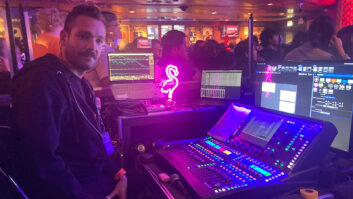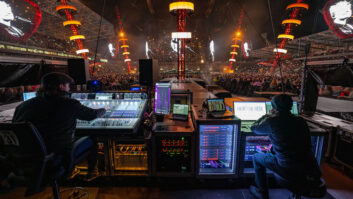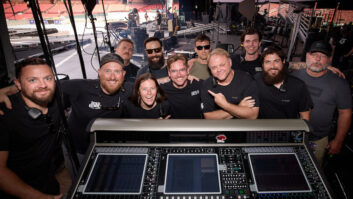The All-American Rejects have been out on the road touring to promote their latest release and have adopted Sennheiser microphones to put across their sweet harmonies and crunchyguitar-driven alternative-rock.
Front-of-house engineer “Supa” Dave Rupsch, who signed up with the band at the beginning of the year, said that Sennheiser’s Evolution Series E 865 vocal microphone works best on bass player and lead singer Tyson Ritter. “I tried a lot of different microphones with Tyson,” said Rupsch. “He does a lot of falsetto and high-range stuff. He has a pretty good range and he’s a great singer.”
After auditioning other mics, Rupsch eventually tried the Evolution E 845, “which worked out well. But once I tried the 865, it really brought out a lot of the falsetto and the breathiness of his voice, which is what we need to have in the mix.” The supercardioid E 865 condenser mic, originally developed by Sennheiser in consultation with Sting’s engineer, brought out the detail in Ritter’s voice. “It made all the difference in the world for his vocals.”
Stage-left and stage-right background vocals, supplied by Ritter’s longtime friend, collaborator and guitarist, Nick Wheeler, and second guitarist Mike Kennerty, are being picked up by Evolution E 845s. “The band’s pretty loud, but the pattern of the mic is great, because they don’t pick up too much cymbal bleed. So the 845s are working out great on the sides,” commentedRupsch. “My input list is about 19 channels and probably 17 of those are Sennheiser mics.” That includes the new E 609 Silver Series. “I tried them on a couple of different placements on the guitars and ended up putting them on the lead guitarist, who does a lot of arpeggio stuff, accenting a lot of what the rhythm guitar player is doing. With just a little bit of compression on those mics, I managed to get everything slammed into the mix. They’re the closest thing I’ve heard to the old Sennheiser 409s.
“I’m using the regular 609 for my rhythm guitar player, and Ihave a 421 on the bass,” Rupsch continued. “But probably my favorite mic, beside the 865, is the 602 that I’m using on the kick drum.” Initially using it in tandem with another mic, “I don’t need to use two kick drum mics at all. It’s got just enough attack and brings my kick drum right out. I don’t have to use hardly any EQ. It’s right there, every night.”
For more on the mics, visit Sennheiser online at www.sennheiserusa.com.







